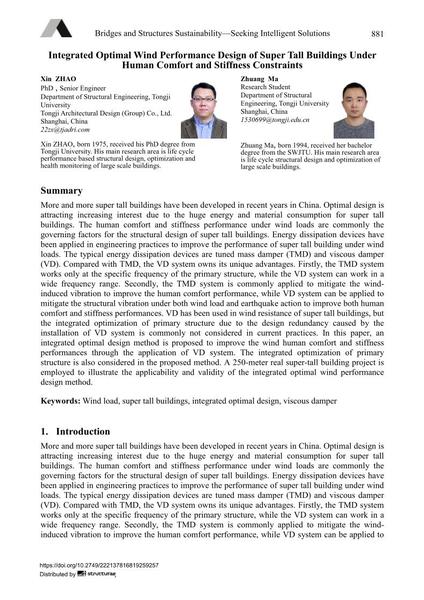Integrated Optimal Wind Performance Design of Super Tall Buildings Under Human Comfort and Stiffness Constraints

|
|
|||||||||||
Détails bibliographiques
| Auteur(s): |
Xin Zhao
Zhuang Ma |
||||
|---|---|---|---|---|---|
| Médium: | papier de conférence | ||||
| Langue(s): | anglais | ||||
| Conférence: | IABSE Conference: Bridges and Structures Sustainability - Seeking Intelligent Solutions, Guangzhou, China, 8-11 May 2016 | ||||
| Publié dans: | IABSE Conference, Guangzhou, China, 8 – 11 May 2016 | ||||
|
|||||
| Page(s): | 881-888 | ||||
| Nombre total de pages (du PDF): | 8 | ||||
| Année: | 2016 | ||||
| DOI: | 10.2749/222137816819259257 | ||||
| Abstrait: |
More and more super tall buildings have been developed in recent years in China. Optimal design is attracting increasing interest due to the huge energy and material consumption for super tall buildings. The human comfort and stiffness performance under wind loads are commonly the governing factors for the structural design of super tall buildings. Energy dissipation devices have been applied in engineering practices to improve the performance of super tall building under wind loads. The typical energy dissipation devices are tuned mass damper (TMD) and viscous damper (VD). Compared with TMD, the VD system owns its unique advantages. Firstly, the TMD system works only at the specific frequency of the primary structure, while the VD system can work in a wide frequency range. Secondly, the TMD system is commonly applied to mitigate the wind- induced vibration to improve the human comfort performance, while VD system can be applied to mitigate the structural vibration under both wind load and earthquake action to improve both human comfort and stiffness performances. VD has been used in wind resistance of super tall buildings, but the integrated optimization of primary structure due to the design redundancy caused by the installation of VD system is commonly not considered in current practices. In this paper, an integrated optimal design method is proposed to improve the wind human comfort and stiffness performances through the application of VD system. The integrated optimization of primary structure is also considered in the proposed method. A 250-meter real super-tall building project is employed to illustrate the applicability and validity of the integrated optimal wind performance design method. |
||||
